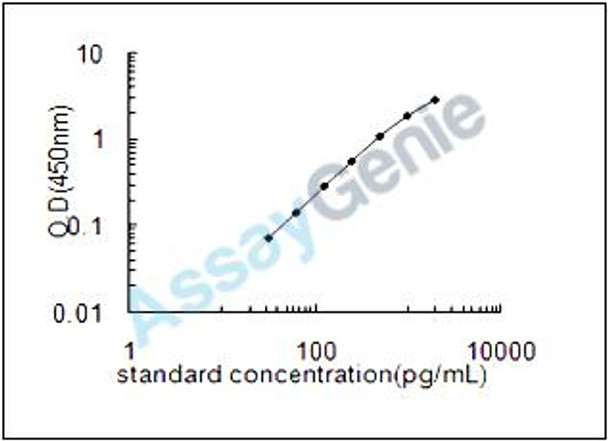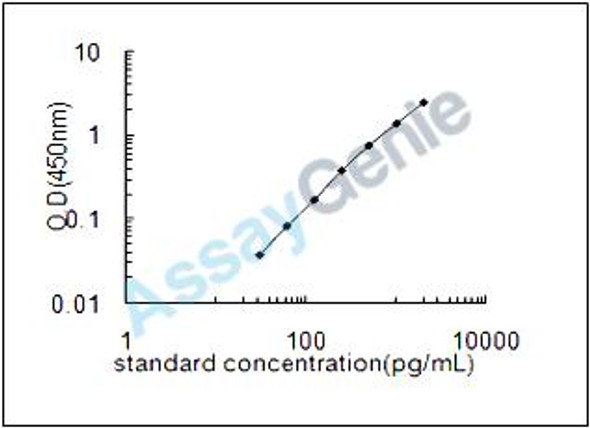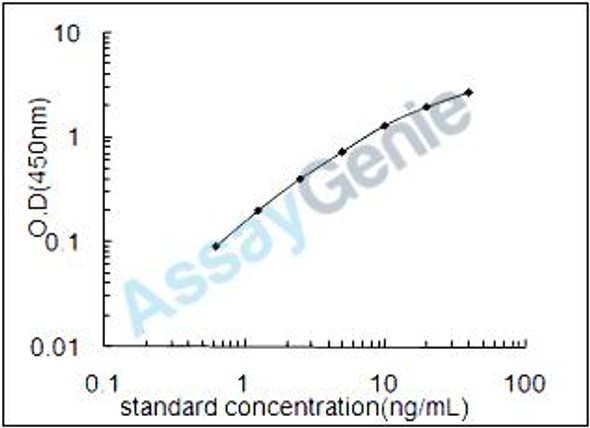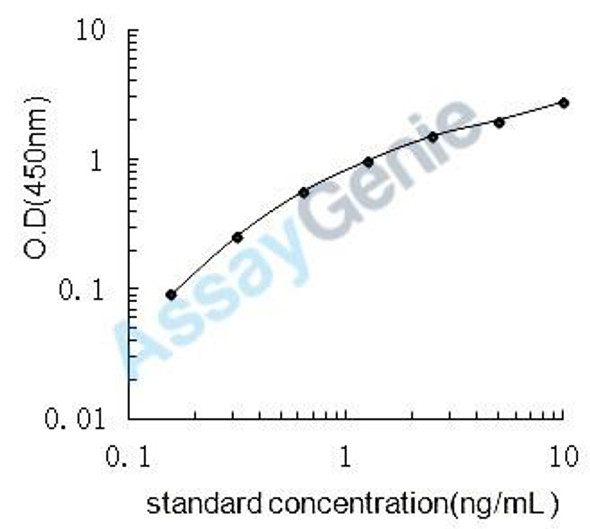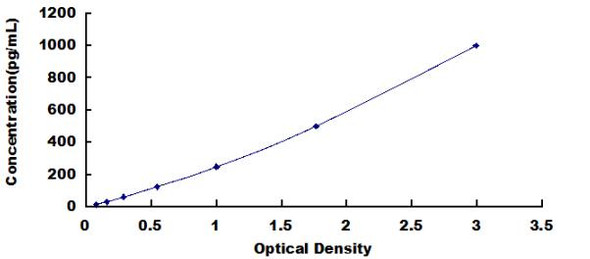Description
Mouse Macrophage colony-stimulating factor 1 receptor (Csf1r) ELISA Kit
The Mouse Macrophage Colony Stimulating Factor 1 Receptor (CSF1R) ELISA Kit is specifically designed for the precise measurement of CSF1R levels in mouse serum, plasma, and cell culture supernatants. With its high sensitivity and specificity, this kit ensures accurate and reproducible results, making it an ideal choice for various research applications.CSF1R, also known as M-CSF receptor, plays a crucial role in macrophage development and function. It is involved in regulating immune responses, inflammation, and tissue repair. Abnormalities in CSF1R signaling have been linked to diseases such as cancer, inflammatory disorders, and metabolic diseases, highlighting the importance of studying this receptor as a potential therapeutic target.
By using the Mouse CSF1R ELISA Kit, researchers can easily quantify CSF1R levels in samples, allowing for a better understanding of its role in various biological processes and diseases. This kit provides a reliable tool for investigating the functions of CSF1R and developing novel interventions for related conditions.
| Product Name: | Mouse Macrophage colony-stimulating factor 1 receptor (Csf1r) ELISA Kit |
| SKU: | MOEB1544 |
| Size: | 96T |
| Target: | Mouse Macrophage colony-stimulating factor 1 receptor (Csf1r) |
| Synonyms: | CSF-1 receptor, Proto-oncogene c-Fms, CSF-1-R, CD115, Csfmr, Fms |
| Assay Type: | Sandwich |
| Detection Method: | ELISA |
| Reactivity: | Mouse |
| Detection Range: | 31.2-2000pg/mL |
| Sensitivity: | 15.76pg/mL |
| Intra CV: | Provided with the Kit |
| Inter CV: | Provided with the Kit |
| Linearity: | Provided with the Kit |
| Recovery: | Provided with the Kit |
| Function: | Tyrosine-protein kinase that acts as cell-surface receptor for CSF1 and IL34 and plays an essential role in the regulation of survival, proliferation and differentiation of hematopoietic precursor cells, especially mononuclear phagocytes, such as macrophages and monocytes. Promotes the release of proinflammatory chemokines in response to IL34 and CSF1, and thereby plays an important role in innate immunity and in inflammatory processes. Plays an important role in the regulation of osteoclast proliferation and differentiation, the regulation of bone resorption, and is required for normal bone and tooth development. Required for normal male and female fertility, and for normal development of milk ducts and acinar structures in the mammary gland during pregnancy. Promotes reorganization of the actin cytoskeleton, regulates formation of membrane ruffles, cell adhesion and cell migration, and promotes cancer cell invasion. Activates several signaling pathways in response to ligand binding. Phosphorylates PIK3R1, PLCG2, GRB2, SLA2 and CBL. Activation of PLCG2 leads to the production of the cellular signaling molecules diacylglycerol and inositol 1,4,5-trisphosphate, that then lead to the activation of protein kinase C family members, especially PRKCD. Phosphorylation of PIK3R1, the regulatory subunit of phosphatidylinositol 3-kinase, leads to activation of the AKT1 signaling pathway. Activated CSF1R also mediates activation of the MAP kinases MAPK1/ERK2 and/or MAPK3/ERK1, and of the SRC family kinases SRC, FYN and YES1. Activated CSF1R transmits signals both via proteins that directly interact with phosphorylated tyrosine residues in its intracellular domain, or via adapter proteins, such as GRB2. Promotes activation of STAT family members STAT3, STAT5A and/or STAT5B. Promotes tyrosine phosphorylation of SHC1 and INPP5D/SHIP-1. Receptor signaling is down-regulated by protein phosphatases, such as INPP5D/SHIP-1, that dephosphorylate the receptor and its downstream effectors, and by rapid internalization of the activated receptor. |
| Uniprot: | P09581 |
| Sample Type: | Serum, plasma, tissue homogenates, cell culture supernates and other biological fluids |
| Specificity: | Natural and recombinant mouse Macrophage colony-stimulating factor 1 receptor |
| Sub Unit: | Monomer. Homodimer. Interacts with CSF1 and IL34. Interaction with dimeric CSF1 or IL34 leads to receptor homodimerization. Interacts with INPPL1/SHIP2 and THOC5. Interacts (tyrosine phosphorylated) with PLCG2 (via SH2 domain). Interacts (tyrosine phosphorylated) with PIK3R1 (via SH2 domain). Interacts (tyrosine phosphorylated) with FYN, YES1 and SRC (via SH2 domain). Interacts (tyrosine phosphorylated) with CBL, GRB2 and SLA2. |
| Research Area: | Immunology |
| Subcellular Location: | Cell membrane Single-pass type I membrane protein The autophosphorylated receptor is ubiquitinated and internalized, leading to its degradation. |
| Storage: | Please see kit components below for exact storage details |
| Note: | For research use only |
| UniProt Protein Function: | CSFR: an oncogenic tyrosine kinase receptor for CSF-1 (M-CSF). Drives growth and development of monocytes. Binding of CSF-1 induces receptor dimerization, activation and autophosphorylation of cytoplasmic tyrosine residues used as docking sites for SH2-containing signaling proteins. There are at least five major tyrosine autophosphorylation sites. Two point mutations seen in 10-20% of patients with acute myeloid leukemia, chronic myelomonocytic leukemia or myelodysplasia. One mutation appears to be both somatic and germline, and disrupts Cbl binding and receptor turnover. v-fms lacks the Cbl binding site and causes feline leukemia. Mutations may also develop after chemotherapy for lymphoma. A distinct point mutation was found in some cases of hepatocellular carcinoma and related to increased expression, and another mutation was found in 2 of 40 patients with idiopathic myelofibrosis. Expression is elevated in breast tumors and cell lines, and expression in xenografts and transgenic mice has been correlated with xenograft growth and breast cancer development. Inhibitors: Ki-20227 and other Kit/PDGFR inhibitors. |
| UniProt Protein Details: | Protein type:Protein kinase, TK; Oncoprotein; EC 2.7.10.1; Protein kinase, tyrosine (receptor); Membrane protein, integral; Kinase, protein; TK group; PDGFR family Cellular Component: cell surface; membrane; plasma membrane; integral to membrane; intracellular; receptor complex Molecular Function:transferase activity; macrophage colony stimulating factor receptor activity; protein binding; protein homodimerization activity; protein-tyrosine kinase activity; cytokine binding; transferase activity, transferring phosphorus-containing groups; nucleotide binding; kinase activity; transmembrane receptor protein tyrosine kinase activity; protein phosphatase binding; ATP binding; protein kinase activity Biological Process: regulation of bone resorption; phosphoinositide-mediated signaling; peptidyl-tyrosine phosphorylation; positive regulation of osteoclast differentiation; immune system process; cytokine and chemokine mediated signaling pathway; protein amino acid autophosphorylation; osteoclast differentiation; protein amino acid phosphorylation; positive regulation of tyrosine phosphorylation of Stat3 protein; cell proliferation; regulation of cell shape; positive regulation of cell proliferation; ruffle organization and biogenesis; innate immune response; hemopoiesis; positive regulation of protein amino acid phosphorylation; phosphatidylinositol metabolic process; inflammatory response; intercellular junction maintenance; phosphorylation; transmembrane receptor protein tyrosine kinase signaling pathway; positive regulation of cell migration |
| UniProt Code: | P09581 |
| NCBI GenInfo Identifier: | 20532397 |
| NCBI Gene ID: | 12978 |
| NCBI Accession: | P09581.3 |
| UniProt Secondary Accession: | P09581,Q3U3P1, Q9DBH9, |
| UniProt Related Accession: | P09581 |
| Molecular Weight: | 109,179 Da |
| NCBI Full Name: | Macrophage colony-stimulating factor 1 receptor |
| NCBI Synonym Full Names: | colony stimulating factor 1 receptor |
| NCBI Official Symbol: | Csf1r |
| NCBI Official Synonym Symbols: | Fms; CD115; Csfmr; Fim-2; CSF-1R; M-CSFR; M-CSF-R; AI323359 |
| NCBI Protein Information: | macrophage colony-stimulating factor 1 receptor; c-fms; CSF-1-R; CSF-1 receptor; proto-oncogene fms; proto-oncogene c-Fms |
| UniProt Protein Name: | Macrophage colony-stimulating factor 1 receptor |
| UniProt Synonym Protein Names: | CSF-1 receptor (EC:2.7.10.1); CSF-1-R; CSF-1R; M-CSF-R; Proto-oncogene c-Fms; CD_antigen: CD115 |
| Protein Family: | Macrophage colony-stimulating factor 1 receptor |
| UniProt Gene Name: | Csf1r |
| UniProt Entry Name: | CSF1R_MOUSE |
| Component | Quantity (96 Assays) | Storage |
| ELISA Microplate (Dismountable) | 8×12 strips | -20°C |
| Lyophilized Standard | 2 | -20°C |
| Sample Diluent | 20ml | -20°C |
| Assay Diluent A | 10mL | -20°C |
| Assay Diluent B | 10mL | -20°C |
| Detection Reagent A | 120µL | -20°C |
| Detection Reagent B | 120µL | -20°C |
| Wash Buffer | 30mL | 4°C |
| Substrate | 10mL | 4°C |
| Stop Solution | 10mL | 4°C |
| Plate Sealer | 5 | - |
Other materials and equipment required:
- Microplate reader with 450 nm wavelength filter
- Multichannel Pipette, Pipette, microcentrifuge tubes and disposable pipette tips
- Incubator
- Deionized or distilled water
- Absorbent paper
- Buffer resevoir
*Note: The below protocol is a sample protocol. Protocols are specific to each batch/lot. For the correct instructions please follow the protocol included in your kit.
Allow all reagents to reach room temperature (Please do not dissolve the reagents at 37°C directly). All the reagents should be mixed thoroughly by gently swirling before pipetting. Avoid foaming. Keep appropriate numbers of strips for 1 experiment and remove extra strips from microtiter plate. Removed strips should be resealed and stored at -20°C until the kits expiry date. Prepare all reagents, working standards and samples as directed in the previous sections. Please predict the concentration before assaying. If values for these are not within the range of the standard curve, users must determine the optimal sample dilutions for their experiments. We recommend running all samples in duplicate.
| Step | |
| 1. | Add Sample: Add 100µL of Standard, Blank, or Sample per well. The blank well is added with Sample diluent. Solutions are added to the bottom of micro ELISA plate well, avoid inside wall touching and foaming as possible. Mix it gently. Cover the plate with sealer we provided. Incubate for 120 minutes at 37°C. |
| 2. | Remove the liquid from each well, don't wash. Add 100µL of Detection Reagent A working solution to each well. Cover with the Plate sealer. Gently tap the plate to ensure thorough mixing. Incubate for 1 hour at 37°C. Note: if Detection Reagent A appears cloudy warm to room temperature until solution is uniform. |
| 3. | Aspirate each well and wash, repeating the process three times. Wash by filling each well with Wash Buffer (approximately 400µL) (a squirt bottle, multi-channel pipette,manifold dispenser or automated washer are needed). Complete removal of liquid at each step is essential. After the last wash, completely remove remaining Wash Buffer by aspirating or decanting. Invert the plate and pat it against thick clean absorbent paper. |
| 4. | Add 100µL of Detection Reagent B working solution to each well. Cover with the Plate sealer. Incubate for 60 minutes at 37°C. |
| 5. | Repeat the wash process for five times as conducted in step 3. |
| 6. | Add 90µL of Substrate Solution to each well. Cover with a new Plate sealer and incubate for 10-20 minutes at 37°C. Protect the plate from light. The reaction time can be shortened or extended according to the actual color change, but this should not exceed more than 30 minutes. When apparent gradient appears in standard wells, user should terminatethe reaction. |
| 7. | Add 50µL of Stop Solution to each well. If color change does not appear uniform, gently tap the plate to ensure thorough mixing. |
| 8. | Determine the optical density (OD value) of each well at once, using a micro-plate reader set to 450 nm. User should open the micro-plate reader in advance, preheat the instrument, and set the testing parameters. |
| 9. | After experiment, store all reagents according to the specified storage temperature respectively until their expiry. |
When carrying out an ELISA assay it is important to prepare your samples in order to achieve the best possible results. Below we have a list of procedures for the preparation of samples for different sample types.
| Sample Type | Protocol |
| Serum | If using serum separator tubes, allow samples to clot for 30 minutes at room temperature. Centrifuge for 10 minutes at 1,000x g. Collect the serum fraction and assay promptly or aliquot and store the samples at -80°C. Avoid multiple freeze-thaw cycles. If serum separator tubes are not being used, allow samples to clot overnight at 2-8°C. Centrifuge for 10 minutes at 1,000x g. Remove serum and assay promptly or aliquot and store the samples at -80°C. Avoid multiple freeze-thaw cycles. |
| Plasma | Collect plasma using EDTA or heparin as an anticoagulant. Centrifuge samples at 4°C for 15 mins at 1000 × g within 30 mins of collection. Collect the plasma fraction and assay promptly or aliquot and store the samples at -80°C. Avoid multiple freeze-thaw cycles. Note: Over haemolysed samples are not suitable for use with this kit. |
| Urine & Cerebrospinal Fluid | Collect the urine (mid-stream) in a sterile container, centrifuge for 20 mins at 2000-3000 rpm. Remove supernatant and assay immediately. If any precipitation is detected, repeat the centrifugation step. A similar protocol can be used for cerebrospinal fluid. |
| Cell culture supernatant | Collect the cell culture media by pipette, followed by centrifugation at 4°C for 20 mins at 1500 rpm. Collect the clear supernatant and assay immediately. |
| Cell lysates | Solubilize cells in lysis buffer and allow to sit on ice for 30 minutes. Centrifuge tubes at 14,000 x g for 5 minutes to remove insoluble material. Aliquot the supernatant into a new tube and discard the remaining whole cell extract. Quantify total protein concentration using a total protein assay. Assay immediately or aliquot and store at ≤ -20 °C. |
| Tissue homogenates | The preparation of tissue homogenates will vary depending upon tissue type. Rinse tissue with 1X PBS to remove excess blood & homogenize in 20ml of 1X PBS (including protease inhibitors) and store overnight at ≤ -20°C. Two freeze-thaw cycles are required to break the cell membranes. To further disrupt the cell membranes you can sonicate the samples. Centrifuge homogenates for 5 mins at 5000xg. Remove the supernatant and assay immediately or aliquot and store at -20°C or -80°C. |
| Tissue lysates | Rinse tissue with PBS, cut into 1-2 mm pieces, and homogenize with a tissue homogenizer in PBS. Add an equal volume of RIPA buffer containing protease inhibitors and lyse tissues at room temperature for 30 minutes with gentle agitation. Centrifuge to remove debris. Quantify total protein concentration using a total protein assay. Assay immediately or aliquot and store at ≤ -20 °C. |
| Breast Milk | Collect milk samples and centrifuge at 10,000 x g for 60 min at 4°C. Aliquot the supernatant and assay. For long term use, store samples at -80°C. Minimize freeze/thaw cycles. |

